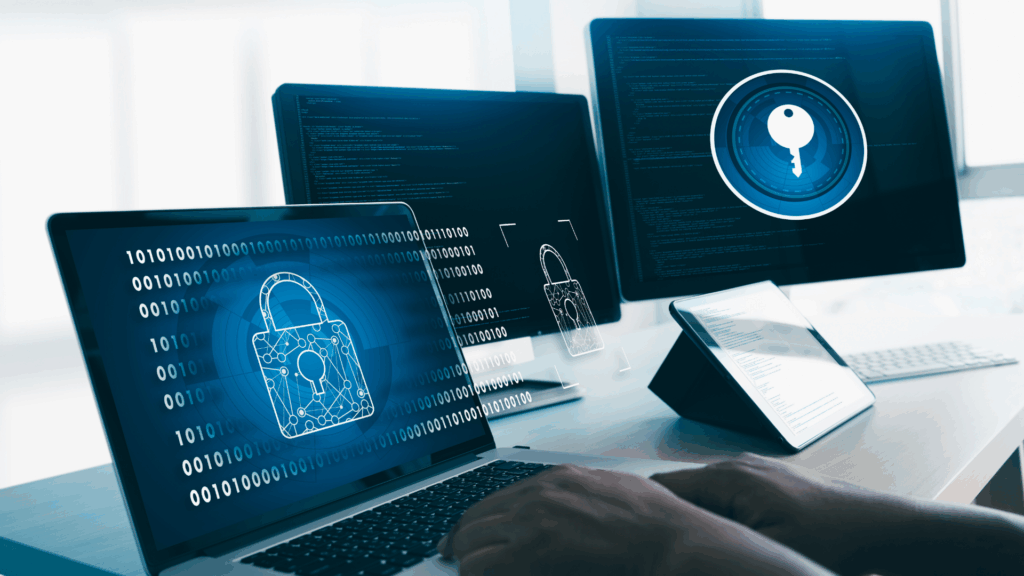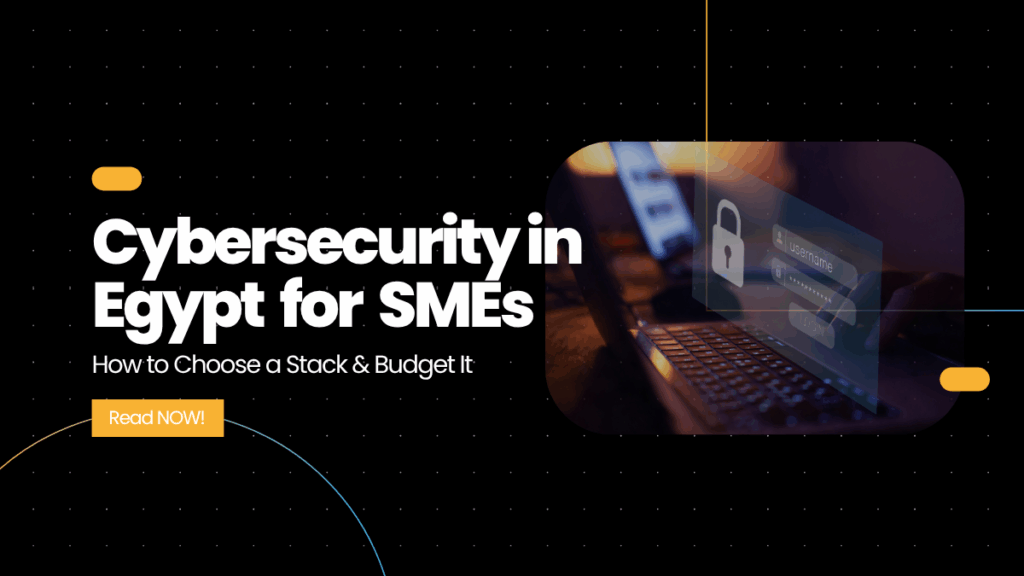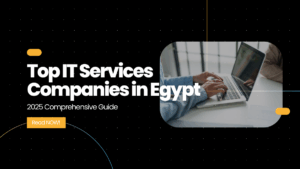Table of Contents
ToggleIntroduction — Why Cybersecurity in Egypt Matters for SMEs Today
Egypt’s SMEs are accelerating digital projects (cloud, e-commerce, remote work) while threat actors become more targeted and automated. A reactive “hope nothing breaks” approach won’t work: ransomware, phishing, and supply-chain attacks can shut an SME down within days. The market for cybersecurity in Egypt is growing fast, and SMEs need a pragmatic plan—one that balances protection, cost and operational reality. Recent market reports put Egypt’s cybersecurity market in the hundreds of millions USD and growing at double-digit CAGRs, signalling both rising demand and rising risk.
Where Threats and Regulation Intersect in Egypt
Threat landscape highlights for Egyptian businesses:
- Phishing and credential theft remain the top vectors for SME compromises. Regional telemetry shows frequent targeted campaigns and DDoS spikes against local sectors.
- Data leakage and exposed databases have been repeatedly observed in 2024–2025, creating both reputational and regulatory exposure.
Regulatory backdrop to watch:
- Egypt enforces Law No.175 (Information Technology Crimes / cybersecurity framework) and an expanding national cybersecurity strategy (2023–2027). These create compliance expectations (incident reporting, lawful handling of personal data) that SMEs must factor into tooling and contracts with providers.
Minimum Viable Security Stack (What to Deploy First)

For resource-constrained SMEs, start with a Minimum Viable Security Stack (MVSS) that eliminates the highest-impact risks quickly:
1. Strong Identity + MFA (single sign-on where possible). Protects cloud accounts and admin consoles.
2. Email & DNS filtering to block phishing and malicious domains before they reach users. Tools to consider: Proofpoint Essentials, Microsoft Defender for Office 365, and cloud DNS filters such as Cisco Umbrella.
3. Endpoint protection (EDR) with managed detection capabilities — not just AV. Managed or cloud EDRs like CrowdStrike Falcon, Microsoft Defender for Business, or Bitdefender GravityZone offer detection + basic response for endpoints.
4. Automated backup + tested restore (cloud backups + immutable snapshots). Acronis, Veeam, or cloud-native snapshots are typical choices.
5. Patch management + automated updates (via RMM tools or MDM).
6. Security awareness training & phishing simulations — quick wins in reducing credential compromise. Services: KnowBe4, Cofense, or local partners offering Arabic content.
These controls dramatically cut the probability of common attacks and are your first budgeting targets.
EDR vs XDR — Practical Choice Guidance for SMEs
EDR (Endpoint Detection & Response) and XDR (Extended Detection & Response) are often compared, but they serve different scopes:
- EDR focuses on endpoints: process telemetry, local alerts, threat hunting on machines. Good if your primary assets are laptops/servers and you want endpoint visibility quickly. Managed EDR providers can onboard fast and are cost-efficient for SMEs.
- XDR ingests telemetry from multiple sources (endpoints, network, email, cloud) and correlates events for broader detection and automated response across layers. XDR reduces blind spots but is operationally heavier and often comes as a managed offering (MXDR). XDR makes sense for SMEs that already use cloud email, cloud infrastructure, and have multiple data sources to correlate.
Practical rule: start with a robust managed EDR (get endpoint coverage + detection). Move to XDR/MXDR once you have: centralized logs, email and cloud controls, and either an internal SOC capability or an MSSP that offers XDR services.
Advanced Extensions — What to Add After the MVSS
Once the MVSS (Minimum Viable Security Stack) is stable, expand the stack with tools that add visibility and resilience:
- SIEM or cloud log management (e.g., Elastic Stack, Microsoft Sentinel) for central logging and compliance reporting. Useful for incident investigation and meeting reporting obligations.
- MDR / SOC-as-a-Service (for 24/7 detection) from a trusted MSSP—this is where local MSSPs and global providers differ. Local vendors often offer Arabic support and regional IR experience. Microminder Cybersecurity
- Vulnerability Scanning & SCA (Snyk, Qualys, Rapid7) for application security and known CVE management.
- Data loss prevention (DLP) where sensitive data (customer IDs, financial data) is at risk.
- Zero Trust Network Access (ZTNA) and conditional access for remote users.
- Incident Response retainer and tabletop planning — budget this as an insurance policy.
Picking Vendors & Providers in Egypt — Local Realities

When evaluating tools and MSSPs, prioritize:
- Local/regional presence — quick on-site support, Arabic communications and contractual clarity. A list of active Egyptian cybersecurity firms includes Keys Cyber, Microminder and others offering managed services.
- Integrations & operability — can the EDR feed into your SIEM/XDR? Can email controls feed threat intelligence? Open telemetry and APIs matter.
- Detection proof & transparency — ask for live demos showing detection-to-response timelines, sample dashboards, and playbooks.
- Compliance & contractual SLAs — data handling, breach notification times, and forensic support.
- Vendor consolidation vs best-of-breed: consolidation reduces integration overhead; best-of-breed can give superior coverage but demands integration and orchestration.
Budgeting — Realistic Numbers and Phasing
Budgeting depends on scale and desired service level. Public market data and MSSP surveys show wide ranges; managed EDR services commonly land in the $5–$25 per endpoint/month band for basic managed EDR and can rise for full 24/7 MXDR. MSSP pricing models vary (per user, per endpoint, or flat tier). Use these quick rules:
- Phase 1 — MVSS (identity + email/DNS + EDR + backups + training): expect roughly $6–$20 per user/month for a managed bundle in many markets (local pricing in Egypt may be slightly lower or comparable depending on provider). This covers cloud detection, email filtering, and backups at a basic managed level.
- Phase 2 — Extended coverage (SIEM/MDR/XDR, 24/7): costs climb—budget an additional $10–$40 per user/month depending on SOC depth, retention and log volumes.
- CapEx considerations: hardware, secure backups and any on-prem network appliances.
Phasing tip: Start with user protection and email, then add endpoint detection and backups, and only after that consider SIEM/MDR or XDR.
(These numbers are directional; get quotes from 3 local MSSPs and compare exact inclusions, e.g., log retention, response windows.)
Which Controls Reduce Risk Fastest?
If you can only do 3 things in year one, prioritize:
1. MFA + strong identity controls — prevents credential reuse and many compromises.
2. Email + DNS filtering — blocks most phishing/malware delivery.
3. Managed EDR + backups — detects/responds to endpoint compromises and ensures recoverability.
These three dramatically reduce attack surface and improve recovery after incidents.
Measuring Effectiveness & ROI on Security
Show internal value with measurable metrics:
- MTTD (Mean Time to Detect) and MTTR (Mean Time to Respond) — if MTTD drops from days to minutes, that’s measurable risk reduction.
- Number of blocked phishing attempts and successful user reports (phish click rate in simulations).
- Ransomware incidents prevented vs industry baseline (use public threat reports for benchmarks).
- Downtime avoided and estimated business loss prevented by having tested backups (model lost revenue per hour × hours saved).
- Compliance incidents avoided (fines, customer breaches) — quantify potential exposure and show how controls reduce that exposure.
Use MSSP reporting dashboards and occasional 3rd-party audits to prove results to stakeholders.
Practical Procurement & Onboarding Checklist

- Run a 90-day pilot with logs and detection enabled, not a “paper” demo.
- Test phishing simulations + tabletop IR during trial.
- Validate restores from backups and end-to-end incident exercises.
- Negotiate SLAs & playbooks (who does what when an incident occurs).
- Ensure training and knowledge transfer—don’t buy a black box.
Conclusion — An Action Plan for SMEs in Egypt
cybersecurity in egypt for SMEs is a risk management and business continuity priority—not an IT luxury. Start with the Minimum Viable Security Stack (identity/MFA, email/DNS, managed EDR, backups, training), measure outcomes with MTTD/MTTR and phishing metrics, and phase into SIEM/MDR/XDR as you scale. Prioritize local vendors for quicker support, but choose tools with open integrations so you can evolve without vendor lock-in.
FAQs
Q1: What’s the minimum viable stack for SMEs?
Identity (SSO + MFA), email/DNS filtering, managed EDR, cloud backups and basic patch management, plus phishing awareness training.
Q2: EDR vs XDR—what should I pick?
Start with managed EDR for immediate endpoint protection. Move to XDR when you need cross-environment correlation (email, network, cloud) and you have either an internal SOC or a trusted MDR provider.
Q3: How much should I budget per user?
For a basic managed bundle expect roughly $6–$20 per user/month depending on exact services; extended MDR/XDR can add $10–$40+ per user/month. Get 3 local MSSP quotes for exact figures.
Q4: Which controls reduce risk fastest?
MFA/identity controls, email/DNS filtering and managed endpoint detection (EDR) provide the biggest early reductions in compromise risk.
Q5: How do I measure ROI on security?
Track MTTD/MTTR, phishing click rates, incidents prevented, downtime avoided and estimated monetary losses averted. Use MSSP dashboards and periodic third-party audits to validate gains.
Secure Your Business Before It’s Too Late
Building the right cybersecurity stack in Egypt doesn’t have to be overwhelming. PyramidBITS helps SMEs design and implement tailored EDR, email security, and backup solutions that fit both your budget and compliance needs.
Get a free cybersecurity assessment today — discover your weakest links and learn how to fix them fast.
Contact PyramidBITS to schedule your consultation.
Resources
- Egypt cybersecurity market forecasts and size. Mordor Intelligence & Market Report Analytics
- Country threat telemetry (Netscout) and regional attack trends. NETSCOUT
- Law No. 175 translation and national cybersecurity strategy context. Andersen Egypt & Digital Watch Observatory
- EDR vs XDR explainer (Microsoft / CrowdStrike / Acronis).
- Managed EDR cost guidance. Eventus Security
- Trend Micro risk-based approach and XDR commentary. Trend Micro



